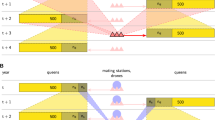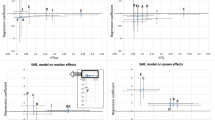Abstract
Workers from colonies of Cape honeybees show marked phenotypic differences in performance in proboscis extension reflex (PER) conditioning. Analysis of these differences using parthenogenetic offspring groups permitted the estimation of genotypic values and revealed a high degree of genetic variability that is evident among related as well as unrelated bees. The results obtained from related groups are of particular importance, since they demonstrated the existence of strong genetic variability among individuals of the same colony. Quantitative analysis yielded high estimates of additive genetic effects and low estimates of dominance effects. Selection of individual workers resulted in an explicit increase in genetic variance of the next generation (G1). However, selection of bees from the parthenogenetic G1 generation, which was done to obtain parthenogenetic G2 offspring, did not lead to further improvement in selection. This observation suggests that recombination of linked genes underlying proboscis extension reflex was neglible during selection in parthenogenetic groups. Taken together with further behavioral analysis (Brandes and Menzel, 1990; Brandes et al., 1988), results from these quantitative genetic experiments suggest that additive genetic factors contribute significantly to variability among individuals for associative learning.
Similar content being viewed by others
References
Anderson, R. H. (1963). The laying worker in the Cape honeybeeApis mellifera capensis.J. Apic. Res. 2:85–92.
Bitterman, M. E., Menzel, R., Fietz, A., and Schäfer, S. (1983). Classical conditioning of proboscis extension in honeybees (Apis mellifera).J. Comp. Psych. 97:107–109.
Brandes, Ch. (1987). Effects of selection on learning behavior in honeybees (Apis mellifera capensis). In Rembold, H., and Eder, J. (eds.),Chemistry and Biology of Social Insects, Verlag J. Peperny, München, pp. 192–193.
Brandes, Ch. (1988). Estimation of heritability of learning behavior in honeybees (Apis mellifera capensis).Behav. Genet. 18:119–132.
Brandes, Ch., and Menzel, R. (1990). Common mechanisms in proboscis extension conditioning and visual learning revealed by genetic selection in honeybees (Apis mellifera capensis).J. Comp. Physiol. 166:545–552.
Brandes, Ch., Frisch, B., and Menzel, R. (1988). Time course of memory formation in honeybee lines selected for good and poor learning.Anim. Behav. 36:981–985.
Calderone, N. W., and Page, R. E. (1988). Genotypic variability in age polyethism and task specialization in the honeybee, Apis mellifera (Hymenoptera: Apidae).Behav. Ecol. Sociobiol. 22:17–25.
Cornuet, J.-M., Daoudi, A., and Chevalet, C. (1986). Genetic pollution and number of matings in a black honeybee (Apis mellifera mellifera) population.Theor. Appl. Genet. 73:223–227.
Falconer, D. S. (1981).Introduction to Quantitative Genetics, 2nd ed., Longmans, London.
Frumhoff, P. C., and Baker, J. (1988). A genetic component to division of labor within honeybee colonies.Nature 333:358–361.
Hillesheim, E., Koeniger, N., and Moritz, R. F. A. (1989). Colony performance in honeybees (Apis mellifera capensis Esch.) depends on the proportion of subordinate and dominant workers.Behav. Ecol. Sociobiol. 24:291–296.
Kuwabara, M. (1975). Bildung des bedingten Reflexes von Pavlovs Typus bei der HonigbieneApis mellifica.Hokkaido Univ. Zool. J. 23 Fac. Sci. 13:458–464.
Laidlaw, H. H., and Page, R. E. (1984). Polyandry in honeybees (Apis mellifera L.). Sperm utilization and intracolony relationships.Genetics 108:985–997.
Lauer, J., and Lindauer, M. (1971). Genetisch fixierte Lerndispositionen bei der Honigbiene. InInformationsaufnahme und Informationsverabeitung im lebenden Organismus. Abh. Akad. Wiss. Mainz 1:1–87.
Lauer, J., and Lindauer, M. (1985). Lernprozesse im Orientierungsverlauf der Honigbiene. Ein rassenspezifischer Vergleich von Apis mellifica carnica und Apis mellifica ligustica.Abh. Akad. Wiss. Mainz 2:1–88.
Lindauer, M. (1952). Ein Beitrag zur Frage der Arbeitsteilung im Bienenstaat.Z. vergl. Physiol. 34:299–345.
Menzel, R. (1969). Das Gedächtnis der Honigbiene für Spektralfarben. II. Umlernen und Mehrfachlernen.Z. vergl. Physiol. 56:329–334.
Menzel, R., and Bitterman, M. E. (1983). Learning by honeybees in an unnatural situation. In Huber, F., and Markl, H. (eds.),Neuroethology and Behavioral Physiology, Springer Verlag, Berlin, Heidelberg, New York, pp. 206–215.
Menzel, R., Freudel, H., and Rühl, U. (1973). Rassenspezifische Unterschiede im Lernverhalten der Honigbiene (Apis mellifica L.).Apidologie 4(1):1–24.
Menzel, R., Frber, J., and Masuhr, Th. (1974). Learning and memory in the honeybee. In Barton Browne, L. (ed.),Experimental Analysis of Insect Behaviour, Springer Verlag, Berlin, Heidelberg, New York, pp. 195–217.
Moritz, R. F. A. (1983). Homogeneous mixing of honeybee semen.J. Apic. Res. 22:249–255.
Moritz, R. F. A. (1986). Intracolonial worker relationship and sperm competition in the honeybee (Apis mellifera L.).Experientia 42:455–458.
Moritz, R. F. A., and Brandes, Ch. (1987). Behavior genetics of honey bees (Apis mellifera L.). In Menzel, R., and Mercer, E. (eds.),Neurobiology and Behavior in Honeybees, Springer Verlag, Berlin, Heidelberg, New York.
Moritz, R. F. A., and Hillesheim, E. (1985). Inheritance of dominance in honeybees (Apis mellifera capensis Esch.).Behav. Ecol. Sociobiol. 17:87–89.
Oldroyd, B., and Moran, C. (1983). Heritability of worker characters in the honeybee (Apis mellifera).Aust. J. Biol. Sci. 36:323–332.
Robinson, G. E., and Page, R. E. (1988). Genetic determination of guarding and undertaking in honeybee colonies.Nature 333:356–358.
Robinson, G. E., Page, R. E., Strambi, C., and Strambi, A. (1989). Hormonal and genetic control of behavioral integration in honeybee colonies.Science 246:109–112.
Rothenbuhler, W. C. (1967). Genetic and evolutionary considerations of social behavior of honeybees and some related insects. In Hirsch, J. (ed.),Behavior-Genetic Analysis, McGraw-Hill, New York, pp. 61–106.
Ruttner, F. (1977). The problem of the Cape bee (Apis mellifera capensis Escholtz): Parthenogenesis—size of populations—evolution.Apidologie 8:281–294.
Ruttner, F., and Hesse, B. (1981). Rassenspezifische Unterschiede in der Ovarentwicklung und Eiablage von weisellosen Arbeiterinnen der HonigbieneApis mellifera L. Apidologie 12(2):159–183.
Sachs, L. (1984).Angewandte Statistik, Springer Verlag, Berlin.
Seeley, T. D., and Levien, R. A. (1987). Social foraging by honeybees: How a colony tracks rich sources of nectar. In Menzel, R., and Mercer, E. (eds.),Neurobiology and Behavior in Honeybees, Springer Verlag, Berlin, Heidelberg, New York, pp. 21–35.
Velthuis, H. H. W. (1970). Ovarian development in Apis mellifera worker bees.Entomol. Exp. Appl. 13:377–394.
Verma, S., and Ruttner, F. (1983). Cytological analysis of the thelytokous parthenogenesis in the Cape honeybee (Apis mellifera capensis ESCHOLTZ).Apidologie 14:(1):41–57.
Weber, E. (1967).Grundriss der biologischen Statistik, Gustav Fischer Verlag, Stuttgart.
Winston, M. L., and Fergusson, L. A. (1985). The effect of worker loss on temporal caste structure in colonies of the honeybee (Apis mellifera L.).Can. J. Zool. 63:777–780.
Wright, S. (1922). Coefficients of inbreeding and relationship.Am Nat. 56:330–338.
Woyke, J. (1986). Sex determination. In Rinderer, Th. E. (ed.),Bee Genetics and Breeding, Academic Press, Orlando, pp. 91–119.
Author information
Authors and Affiliations
Additional information
This work was supported by a fellowship from the Deutsche Forschnungsgemmeinschaft (Br 827/1, Br 827/2).
Rights and permissions
About this article
Cite this article
Brandes, C. Genetic differences in learning behavior in honeybees (Apis mellifera capensis). Behav Genet 21, 271–294 (1991). https://doi.org/10.1007/BF01065820
Received:
Accepted:
Issue Date:
DOI: https://doi.org/10.1007/BF01065820




